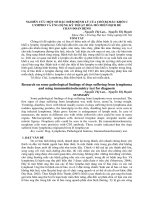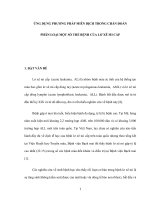MIỄN DỊCH HỌC CHẨN ĐOÁN GIUN SÁN KÝ SINH
Bạn đang xem bản rút gọn của tài liệu. Xem và tải ngay bản đầy đủ của tài liệu tại đây (1.52 MB, 39 trang )
Xét nghiệm miễn
dịch học chẩn
đoán Giun – Sán
ký sinh
Mục tiêu
• Trình bày được ngun lý của các kỹ thuật
miễn dịch học chẩn đốn giun sán.
• Thực hiện được xét nghiệm ELISA chẩn đoán
một số bệnh ký sinh trùng thường gặp.
2
Nội dung
Giới thiệu
Kỹ thuật ngưng kết hồng cầu gián tiếp
ELISA gián tiếp
Kỹ thuật ngưng kết hạt Latex
Sandwich ELISA
Dipsticks assay/Chromatography
Immunoblot assay
Kỹ thuật khác
Kết luận
3
Giới thiệu
4
IgG và IgE hợp tác loại bỏ
S. venezuelensis
(A) To examine which classes of Igs are able to induce worm expulsion. We injected IgG Fr (1.8 mg), IgE Fr (5
μg), or a mixture of IgG Fr (1.8 mg) and IgE Fr (5 μg) into AID−/− mice on day 7 after infection with 4,000 L3,
and adult worms were recovered at day 8. As shown here, IgG and IgE reduced worm burdens
collaboratively. (B) Hypothetical mechanism of IgG- and IgE-mediated worm expulsion.
5
•
IL-12 and parasite infection. Early in infection with intracellular parasites, IL-12 is produced
by phagocytic cells and induces the production of IFN-γ by natural killer (NK) cells and T cells.
This early production of IFN-γ may help control infection by immediately activating
macrophages. In addition, IL-12 and the IL-12-driven cytokine IFN-γ favour the development
of parasite-specific TH1 cells, in addition to inducing the production of high levels of IFNγ by
already differentiated TH1 cells
•
This early production of Il-12 is functionally analogous to the early induction of IL-4 synthesis by
helminthic parasites, which drives TH2 development. Any helminthic parasite that does not induce
the production of IL-12 may contribute to the development of TH2 as a default pathway
Mechanisms of immune modulation by helminth ES products (in bold) and defined molecules
(in plain type) discussed in the text. Abbreviations: APC, antigen presenting cell; ASP,
Ancylostoma secreted protein; BES, B. malayi ES; CPI, cysteine proteinase inhibitor
(cystatin); HES, H. polygyrus ES; IPSE, IL-4-inducing principle of schistosome eggs; L-NES,
larval N. brasiliensis ES; MIF, macrophage migration inhibitory factor; NES, adult N.
brasiliensis ES; NIF, neutrophil inhibitory factor; Sm, Schistosoma mansoni; SPN, serine
proteinase inhibitor (serpin); TLR, toll-like receptor; TGF, transforming growth factor; TES,
T. canis ES.
Protective TH2-type response during intestinal nematode
infection
•
Infective third-stage larvae (L3) are ingested by the host. They then travel to the duodenum, invade the epithelia, and reside in the submucosa for 8 days, after which they reenter the lumen of the duodenum as adult nematodes. Primary infections become established and chronic, but can be cleared by antihelminthic drug treatment. Challenge
(secondary) infections are naturally cleared by the host by day 14 post-infection, making this an excellent model of protective memory T helper 2 (TH2)-type responses.
Parasite antigens are presented to CD4+ T cells in mesenteric lymph nodes and other gut-associated lymphoid tissues, driving the induction of TH2 effector cells. These cells
exert their effector functions through the production of a number of cytokines, including interleukin-4 (IL-4), IL-13, IL-9 and IL-5. TH2 cells induce B-cell immunoglobulin classswitching to IgE. Shortly after activation, TH2 effector cells migrate to the site of parasite residence in the submucosa. Within several days, a distinct immune-cell infiltrate
appears which can damage the larval parasite after secondary, but not primary, inoculation. The infiltrate following secondary inoculation includes TH2 cells, dendritic cells
(DCs), neutrophils and alternatively activated macrophages (AAMs). The TH2 cytokines IL-4 and IL-13 might also facilitate expulsion of adult parasites in the lumen by inducing
changes in intestinal physiology.
TH2-cell functions during helminth infection
•
T helper 2 (TH2) cells orchestrate the immune response primarily through the production of cytokines in the lymph nodes and
periphery. Interleukin-5 (IL-5) triggers eosinophilia, and in conjunction with IL-4, IL-9, and IL-13, and the crosslinking of FcεRIs
(high-affinity Fc receptors for IgE), can result in enhanced mast-cell and basophil development and release of mediators. IL-4
and IL-13 stimulate increased smooth-muscle-cell contractility, increased intestinal permeability and elevated goblet-cell
mucous secretion. IL-4 and IL-13 also enhance responsiveness of these cell types to mast-cell-derived mediators. Collectively,
these effects can contribute to the ‘weep and sweep’ response to intestinal helminths. IL-4, in conjunction with other signals,
can induce class switching in B cells, leading to IgE production. IL-4, IL-13 and IL-21, can drive development of alternatively
activated macrophages (AAMs), leading to upregulation of arginase-1 expression, and in some cases this might lead to fibrosis,
as in chronic schistosomiasis. IL-25 expression stimulates a c-KIT+FcεRI− population to migrate to lymph nodes and upregulate
TH2-type cytokine mRNAs. It is unclear whether IL-25 is a TH2-type cytokine, or whether it is expressed by a distinct TH-cell
lineage. IL-21, also produced by TH17 cells, is instrumental in the development of a TH17-like response (not shown). ChaFFs,
chitinase and FIZZ family members; RELM, resistin-like molecule.
T helper and regulatory cells
•
•
•
•
•
•
•
•
•
•
•
•
•
•
•
•
•
•
•
•
•
•
•
Naive CD4+ T cells can differentiate into several different types of effector and regulatory cells
during helminth infection. Specific cytokines and transcription factors contribute to
differentiation and expansion of these cell populations, and their differential activation plays
a major role in determining whether an immune response will contribute to host protection or
pathological inflammation. Exposure to interleukin-12 (IL-12) produced by antigen-presenting
dendritic cells (DCs) induces T-bet expression, driving T helper 1 (TH1)-cell differentiation.
These cells produce interferon-γ (IFNγ), and are unable to clear helminth parasites. The
circumstances leading to TH2-cell differentiation are not as clear but recently, IL-2, IL-25 and
thymic stromal lymphopoietin (TSLP), and associated transcription factors, have been
implicated. TH2 cells produce a panel of cytokines that contribute to antihelminth immunity
by instructing innate bone-marrow- and non-bone-marrow-derived cells, which in turn can
instruct and amplify TH2 cells. Strong TH2-type responses often lead to increased resistance
to parasites, as seen in Heligmosomoides polygyrus infection, or control of harmful
inflammation mediated by TH1 cells and TH17 cells, as in schistosomiasis. However, chronic
potent TH2-cell responses can also lead to harmful TH2-type inflammatory responses including
fibrosis. Expression of the transcription factor forkhead box P3 (FOXP3) along with the
cytokines transforming growth factor-β (TGFβ) and IL-2, leads to differentiation of regulatory
T cells (TReg cells), which can inhibit the immune response. Several factors, including retinoicacidreceptor-related orphan receptor-γ (RORγ), TGFβ, IL-6, IL-21 and IL-23, have been
shown to promote TH17-cell differentiation, and these effector cells can mediate harmful
inflammation. IL-10, which is no longer considered to be exclusively a TH2-type cytokine, can
be produced by TH1, TH2, and TRegcells and downregulates both TH1- and TH2-type responses.
TNF, tumour-necrosis factor.
Parasite-derived immune modulators function at several levels on crucial immune regulatory cells. Cytokine mimics, such as
macrophage-migration inhibition factor (MIF) and transforming growth factor- (TGF-), that are present in helminths such
as Brugia malayi can modulate macrophage function and lead to the induction of T helper 2 (T H2) cells and immune
suppression. Non-protein signature molecules (for example, from Schistosoma mansoni) such as phosphatidylserine (PS)
and lyso-PS, phosphorylcholine and a range of glycans (such as di-N-acetyl-difucosylated lactose, lacto-n-fucopentaose III
and lacto-N-neotetraose) can interact with dendritic cells and result in the induction of both T H2- and regulatory T (TReg)cell phenotypes. Helminths also produce prostaglandins PGD 2 and PGE2, which can have similar effects on accessory cells
(not shown). Direct interference with antigen presentation by parasite-derived cystatins (such as CPI2 from B. malayi and
onchocystatin from Onchocerca volvulus) prevents T-cell activation both at the level of T-cell receptor engagement by
peptide–MHC complexes (by inhibiting proteases involved in antigen presentation), and by enhancing the production of
interleukin-10 (IL-10) by accessory cells.
Miễn dịch học với nhiễm ký sinh trùng
Giun sán là đa bào
nhiều loại antigen khác nhau, nhiều giai đoạn
phát triển khác nhau.
Kết quả của phản ứng miễn dịch với giun sán:
– Miễn dịch hoàn toàn: nhiễm bệnh, tự chữa bệnh và bảo
vệ cho các lần tiếp theo.
– Miễn dịch khơng hồn tồn: nhiễm bệnh, giảm số lượng
KST và bệnh, không thể bảo vệ cho lần tiếp theo.
– Chẩn đoán miễn dịch học
13
Kỹ thuật chẩn đốn Ký sinh trùng
Kỹ thuật
Ưu điểm
Hình thái
- Đơn giản
học
- Con trưởng - Chuẩn vàng
- Có thể xác định hầu
thành
hết các loại trứng giun
- Trứng hoặc sán
ấu trùng
Nhược điểm
- Rất khó khăn trong
việc thu hồi con giun –
sán từ người
-Khó khăn trong việc
phân biệt một số lồi
tương đối giống nhau
(Cs & Ov & MIF)
- Trong trường hợp
nhiễm nhẹ
14
Kỹ thuật chẩn đoán Ký sinh trùng
Kỹ thuật
Ưu điểm
- Đơn giản, nhanh và có
Miễn
thể nhìn kết quả bằng mắt
dịch học thường
- Độ nhạy & độ đặc hiệu
cao
Sinh học - Độ đặc hiệu cao
phân tử - Có thể xác định được
dưới nhóm
Nhược điểm
- Nhiễm chép giữa các
loại
- Trong trường hợp tiếp
xúc với tác nhân gây bệnh
(đối với xác định KT)
- Độ nhay còn chưa cao
- Cần trang thiết bị đăt
tiền và KTV được đào tạo
- Khó áp dụng hàng loạt ở
cộng đồng
15
Miễn dịch học chẩn đốn KST
• Xác định kháng thể:
– Chủ yế là IgG, ngoài ra IgA, IgM & IgE
– Ưu điểm: số lượng lớn mẫu, độ nhạy cao
– Nhược điểm: mới nhiễm và tiếp xúc.
• Xác định kháng nguyên:
– Sử dung kháng thể đơn dòng hoặc đa dòng
– Ưu điểm: số lượng mẫu lớn, mới nhiễm và tiếp xúc
– Nhược điểm: độ đặc hiệu phụ thuộc độ đặc hiệu của kháng thể.
16
Kỹ thuật ngưng kết hồng cầu
gián tiếp
Kháng nguyên hòa
tan của giun sán gắn
với hồng cầu cừu
Kháng thể
Phức hợp kháng
nguyên kháng thể
17
Kỹ thuật ngưng kết hồng cầu
gián tiếp
Sử dụng kháng nguyên toàn phần xác định kháng
thể trong huyết thanh của bệnh nhân
Schistosomiasis
Độ nhạy của kỹ thuật trong xác định S. mansoni, S.
haematobium, và cả 2 là 88.0, 80.0 và 86.0%, độ
đặc hiệu là 98.9%, với ngưỡng là 1:160
Khi ngưỡng 1:80 thì độ nhạy tương ứng là 94.7,
92.0 và 94.0%, độ đặc hiệu là 94.7%
18
(Van Gool et al., 2002)
ELISA gián tiếp
19
Ứng dụng Cysteine Proteinase của
Cs cho chẩn đoán Cs
Kháng nguyên: cathepsin L cysteine proteinases
(37 kDa) của sán lá gan nhỏ C.sinensis
Kháng thể: huyết thanh người nhiễm ký sinh
trùng đã được xác định bằng hình thái học và
lâm sàng
Kết quả: độ nhạy và độ đặc hiệu là 88% và
100%
(Nagano et al., 2004)
20









